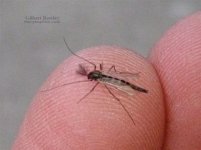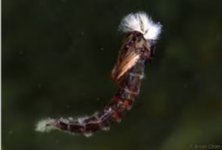afishinado
Moderator
Staff member
Many times the rising fish you see in the winter are taking midges. I’ve done well in the winter fishing midges on warmer afternoons. It’s great covering rising fish fish in the winter since I become tired of dredging the bottom, doing the chuck-and-chance-it to unseen fish. I could never stand watching fish rise in front of me without giving them a try.
Tying Midges
Midges are not hard to tie. I use a small sized emerger hook which is a wide gape 2x short curved hook. For dries, just add a thread body and a few fibers for wings or a wisp of dubbing for pupa:
Hook: Emerger hook size 20-28
Body: Thread (black, cream, brown, white, olive) to match naturals. I always try to catch a few insects with my net before I select a fly. If I can't capture a natural, I'll usually try black first.
Wing: 8-12 CDC fibers, or Z-lon, or Antron yarn.
I like to use 6/0 or 8/0 thread for the body depending on the brand of thread and the size of the fly. The body should remain thin like the natural. (see pic of adult midge below)
Start the thread on the shank behind the eye and wrap it back to the bend. Spin the bobbin to wind the thread tightly by spinning and wrap the thread back to just behind the eye. The tightly wound thread gives a segmented appearance and makes it easier to wrap. On a size smaller fly hook, one pass back and forth is enough to build the body. On larger flies several passes may be needed.
I tie off the heavier thread with finer 12/0 thread to finish the fly. Cut 8-12 CDC fibers (Z-lon or Antron yarn also work) and tie in on top of the hook shank and trim the wing fibers slightly shorter than the body and whip finish. That’s it!...a thread body with some wisps of CDC or yarn for the wing. On larger sized midges I sometimes use a little dubbing the same color as the body to finish off the head.
Don’t make the wings too heavy – sparse fibers look more natural to suggest wings, and adds just enough buoyancy to float the fly in the film like the naturals.
For midge pupa, do the same thread body as above, except instead of wings dub in a small wisp of light colored dubbing fur near the head of the fly or trim a small clump of CDC at the head. (See Midge pupa pic below)
Fishing Midges
With a size 28 fly, I may go down to a 7X tippet, not so much because of visibility of the tippet by the fish, more for getting a good drift. Heavier tippet tends to drag such a small fly around in the water.
Use a fairly long and soft tippet and try to cast some s-curves and slack in your line and tippet to avoid drag. Also, be sure not to cast your leader over the fish. Try to reach mend or curve cast it so the fish see the fly and not your line. Getting a drag-free drift is the key to fooling the fish.
I grease my line down to 1’ or so of the fly and watch the tippet for strikes. If I have problems seeing the tippet, I put a pinch of strike putty on the tippet knot for visibility. When you line moves a little on the take, just tighten up and the battle is on.
After covering a few fish and believing I have gotten some good drifts over them, I will often change over to a pupa pattern that rides in the film. At times they are feeding on pupae.
The hardest part of fishing is often trying not to spook the fish. Careful casting and wading (if you must get into the water) is most important. When fishing to rising fish, I often ease into a casting position and wait until the fish resume rising. Just slow down and try to stay low, and take as few false casts as possible.
In the winter fish are often found rising in the long, slow pools. If there's a deeper bank with rising fish I'll often cross over in the shallow riff below the pool and slowly wade across to deeper bank. Casting from the shallow side will often expose you to the trout, and laying all your line out over the entire width of stream to reach the opposite bank often causes issues trying to get a good drift, especially when trying to dead-drift tiny flies.
After crossing over and most times putting all the rising fish down, I sit along the bank next to a tree or any cover I can find. I proceed to pull out my Wawa shortie and Wawa chocolate milk and began to feast. By the time I am finished, the fish resume rising and I began to target one fish at time. Don’t worry, it’s not just a Philly thing, for those in western and central PA, the strategy works, but not quite as well with Sheetz MTO hoagies and drinks.
Tying and fishing midges is not really that hard. I look forward to it every winter when I tire of nymphing.
Give it a try and good luck.
Tying Midges
Midges are not hard to tie. I use a small sized emerger hook which is a wide gape 2x short curved hook. For dries, just add a thread body and a few fibers for wings or a wisp of dubbing for pupa:
Hook: Emerger hook size 20-28
Body: Thread (black, cream, brown, white, olive) to match naturals. I always try to catch a few insects with my net before I select a fly. If I can't capture a natural, I'll usually try black first.
Wing: 8-12 CDC fibers, or Z-lon, or Antron yarn.
I like to use 6/0 or 8/0 thread for the body depending on the brand of thread and the size of the fly. The body should remain thin like the natural. (see pic of adult midge below)
Start the thread on the shank behind the eye and wrap it back to the bend. Spin the bobbin to wind the thread tightly by spinning and wrap the thread back to just behind the eye. The tightly wound thread gives a segmented appearance and makes it easier to wrap. On a size smaller fly hook, one pass back and forth is enough to build the body. On larger flies several passes may be needed.
I tie off the heavier thread with finer 12/0 thread to finish the fly. Cut 8-12 CDC fibers (Z-lon or Antron yarn also work) and tie in on top of the hook shank and trim the wing fibers slightly shorter than the body and whip finish. That’s it!...a thread body with some wisps of CDC or yarn for the wing. On larger sized midges I sometimes use a little dubbing the same color as the body to finish off the head.
Don’t make the wings too heavy – sparse fibers look more natural to suggest wings, and adds just enough buoyancy to float the fly in the film like the naturals.
For midge pupa, do the same thread body as above, except instead of wings dub in a small wisp of light colored dubbing fur near the head of the fly or trim a small clump of CDC at the head. (See Midge pupa pic below)
Fishing Midges
With a size 28 fly, I may go down to a 7X tippet, not so much because of visibility of the tippet by the fish, more for getting a good drift. Heavier tippet tends to drag such a small fly around in the water.
Use a fairly long and soft tippet and try to cast some s-curves and slack in your line and tippet to avoid drag. Also, be sure not to cast your leader over the fish. Try to reach mend or curve cast it so the fish see the fly and not your line. Getting a drag-free drift is the key to fooling the fish.
I grease my line down to 1’ or so of the fly and watch the tippet for strikes. If I have problems seeing the tippet, I put a pinch of strike putty on the tippet knot for visibility. When you line moves a little on the take, just tighten up and the battle is on.
After covering a few fish and believing I have gotten some good drifts over them, I will often change over to a pupa pattern that rides in the film. At times they are feeding on pupae.
The hardest part of fishing is often trying not to spook the fish. Careful casting and wading (if you must get into the water) is most important. When fishing to rising fish, I often ease into a casting position and wait until the fish resume rising. Just slow down and try to stay low, and take as few false casts as possible.
In the winter fish are often found rising in the long, slow pools. If there's a deeper bank with rising fish I'll often cross over in the shallow riff below the pool and slowly wade across to deeper bank. Casting from the shallow side will often expose you to the trout, and laying all your line out over the entire width of stream to reach the opposite bank often causes issues trying to get a good drift, especially when trying to dead-drift tiny flies.
After crossing over and most times putting all the rising fish down, I sit along the bank next to a tree or any cover I can find. I proceed to pull out my Wawa shortie and Wawa chocolate milk and began to feast. By the time I am finished, the fish resume rising and I began to target one fish at time. Don’t worry, it’s not just a Philly thing, for those in western and central PA, the strategy works, but not quite as well with Sheetz MTO hoagies and drinks.
Tying and fishing midges is not really that hard. I look forward to it every winter when I tire of nymphing.
Give it a try and good luck.





